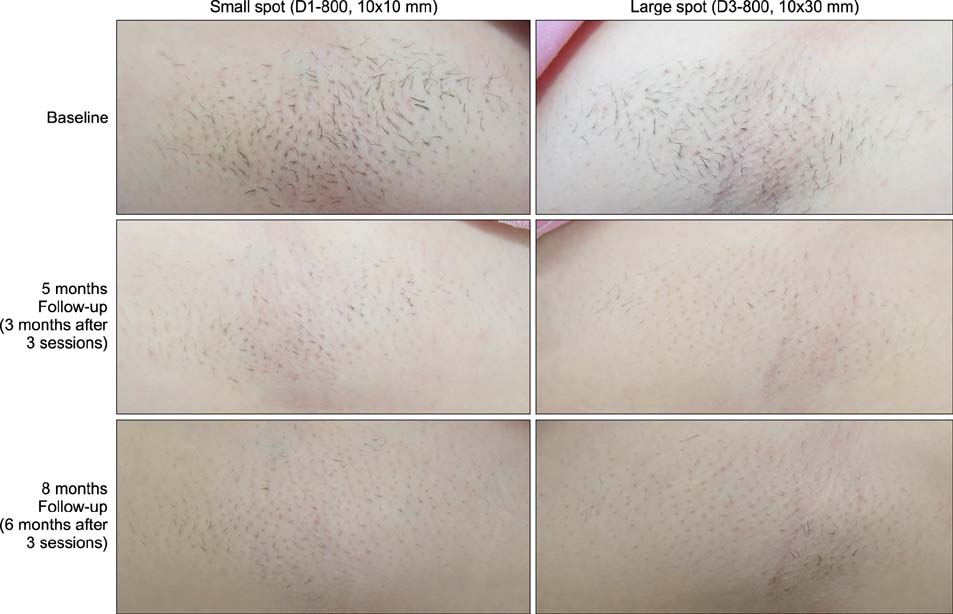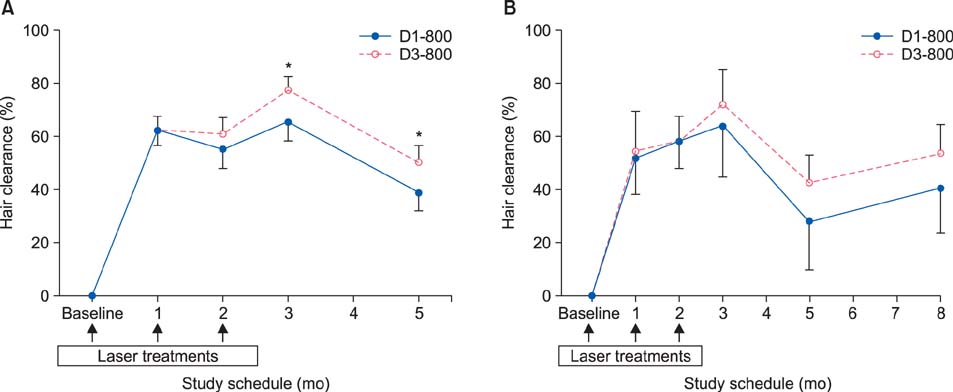Ann Dermatol.
2015 Oct;27(5):517-522. 10.5021/ad.2015.27.5.517.
Efficacy and Safety of Hair Removal with a Long-Pulsed Diode Laser Depending on the Spot Size: A Randomized, Evaluators-Blinded, Left-Right Study
- Affiliations
-
- 1Department of Dermatology, Seoul National University College of Medicine, Seoul, Korea. oskwon@snu.ac.kr
- 2JMO Dermatology, Seoul, Korea. wooseokkoh@hotmail.com
- KMID: 2171451
- DOI: http://doi.org/10.5021/ad.2015.27.5.517
Abstract
- BACKGROUND
The efficacy of the long-pulsed diode laser (LPDL) in hair removal is determined with various physical parameters. Recently, LPDLs with a larger spot size are commercially available; however, the independent effect of spot size on hair removal has not been studied.
OBJECTIVE
This study aimed to compare the efficacy of the LPDL in hair removal depending on the spot size.
METHODS
A randomized, evaluators-blind, intrapatient comparison (left vs. right) trial was designed. Ten healthy Korean women received three hair removal treatment sessions on both armpits with the 805-nm LPDL and followed for 3 months. A 10x10 mm handpiece (D1) or a 10x30 mm handpiece (D3) was randomly assigned to the right or left axilla. The fluence, pulse duration, and epidermal cooling temperature were identical for both armpits. Hair clearance was quantified with high-resolution photos taken at each visit. Postprocedural pain was quantified on a visual analogue scale. Adverse events were evaluated by physical examination and the patients' self-report.
RESULTS
The mean hair clearance at 3 months after three treatment sessions was 38.7% and 50.1% on the armpits treated with D1 and D3, respectively (p=0.028). Procedural pain was significantly greater in the side treated with D3 (p=0.009). Serious adverse events were not observed.
CONCLUSION
Given that the pulse duration, fluence, and epidermal cooling were identical, the 805-nm LPDL at the three times larger spot size showed an efficacy improvement of 29.5% in axillary hair removal without serious adverse events.
Keyword
Figure
Reference
-
1. Han SH, Byun JW, Lee WS, Kang H, Kye YC, Kim KH, et al. Quality of life assessment in male patients with androgenetic alopecia: result of a prospective, multicenter study. Ann Dermatol. 2012; 24:311–318.
Article2. Grossman MC, Dierickx C, Farinelli W, Flotte T, Anderson RR. Damage to hair follicles by normal-mode ruby laser pulses. J Am Acad Dermatol. 1996; 35:889–894.
Article3. Gan SD, Graber EM. Laser hair removal: a review. Dermatol Surg. 2013; 39:823–838.
Article4. Baugh WP, Trafeli JP, Barnette DJ Jr, Ross EV. Hair reduction using a scanning 800 nm diode laser. Dermatol Surg. 2001; 27:358–364.
Article5. Campos VB, Dierickx CC, Farinelli WA, Lin TY, Manuskiatti W, Anderson RR. Hair removal with an 800-nm pulsed diode laser. J Am Acad Dermatol. 2000; 43:442–447.
Article6. Royo J, Urdiales F, Moreno J, Al-Zarouni M, Cornejo P, Trelles MA. Six-month follow-up multicenter prospective study of 368 patients, phototypes III to V, on epilation efficacy using an 810-nm diode laser at low fluence. Lasers Med Sci. 2011; 26:247–255.
Article7. Ilknur T, Biçak MÜ, Eker P, Ellidokuz H, Özkan S. Effects of the 810-nm diode laser on hair and on the biophysical properties of skin. J Cosmet Laser Ther. 2010; 12:269–275.
Article8. Chan HH, Ying SY, Ho WS, Wong DS, Lam LK. An in vivo study comparing the efficacy and complications of diode laser and long-pulsed Nd:YAG laser in hair removal in Chinese patients. Dermatol Surg. 2001; 27:950–954.
Article9. Ibrahimi OA, Kilmer SL. Long-term clinical evaluation of a 800-nm long-pulsed diode laser with a large spot size and vacuum-assisted suction for hair removal. Dermatol Surg. 2012; 38:912–917.
Article10. Pai GS, Bhat PS, Mallya H, Gold M. Safety and efficacy of low-fluence, high-repetition rate versus high-fluence, low-repetition rate 810-nm diode laser for permanent hair removal--a split-face comparison study. J Cosmet Laser Ther. 2011; 13:134–137.
Article11. Galadari I. Comparative evaluation of different hair removal lasers in skin types IV, V, and VI. Int J Dermatol. 2003; 42:68–70.
Article12. Rogachefsky AS, Silapunt S, Goldberg DJ. Evaluation of a new super-long-pulsed 810 nm diode laser for the removal of unwanted hair: the concept of thermal damage time. Dermatol Surg. 2002; 28:410–414.
Article13. Altshuler GB, Anderson RR, Manstein D, Zenzie HH, Smirnov MZ. Extended theory of selective photothermolysis. Lasers Surg Med. 2001; 29:416–432.
Article14. Lou WW, Quintana AT, Geronemus RG, Grossman MC. Prospective study of hair reduction by diode laser (800 nm) with long-term follow-up. Dermatol Surg. 2000; 26:428–432.
Article15. Bäumler W, Scherer K, Abels C, Neff S, Landthaler M, Szeimies RM. The effect of different spot sizes on the efficacy of hair removal using a long-pulsed diode laser. Dermatol Surg. 2002; 28:118–121.
Article16. Anderson RR, Parrish JA. Selective photothermolysis: precise microsurgery by selective absorption of pulsed radiation. Science. 1983; 220:524–527.
Article17. Eremia S, Newman N. Topical anesthesia for laser hair removal: comparison of spot sizes and 755 nm versus 800 nm wavelengths. Dermatol Surg. 2000; 26:667–669.
Article18. Ross EV, Ladin Z, Kreindel M, Dierickx C. Theoretical considerations laser hair removal. Dermatol Clin. 1999; 17:333–355. viii19. Littler CM. Hair removal using an Nd:YAG laser system. Dermatol Clin. 1999; 17:401–430. x20. Nouri K, Chen H, Saghari S, Ricotti CA Jr. Comparing 18-versus 12-mm spot size in hair removal using a gentlease 755-nm alexandrite laser. Dermatol Surg. 2004; 30:494–497.
Article21. Klein A, Steinert S, Baeumler W, Landthaler M, Babilas P. Photoepilation with a diode laser vs. intense pulsed light: a randomized, intrapatient left-to-right trial. Br J Dermatol. 2013; 168:1287–1293.
Article22. Handrick C, Alster TS. Comparison of long-pulsed diode and long-pulsed alexandrite lasers for hair removal: a long-term clinical and histologic study. Dermatol Surg. 2001; 27:622–626.
Article
- Full Text Links
- Actions
-
Cited
- CITED
-
- Close
- Share
- Similar articles
-
- A prospective, comparative evaluation of axillary hair removal with an 808-nm diode laser at different fluences
- Facial Scar Treatment Using 585nm Pulsed Dye Laser
- Comparison of Photocoagulation with the Argon and Diode Laser in Rabbit Eyes
- Hair Remeval utilzing a Long-pulsed Alexandrite Laser
- Axillary Hair Removal Using Long Pulse Alexandrite Laser



